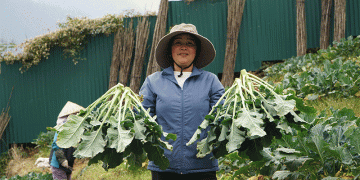India is home to a rich diversity of vegetables, many of which are not commonly found outside the country. These lesser-known vegetables are not only packed with essential nutrients but also bring unique flavors to the table. From green jackfruit to sword beans, each of these vegetables offers distinct health benefits and culinary uses. Here are ten such nutrient-dense vegetables that can enhance your diet and provide valuable insights into traditional Indian cuisine.
- Green Jackfruit (Kathal)
Green jackfruit is a versatile vegetable often used as a meat substitute in vegetarian dishes due to its fibrous texture. It absorbs flavors exceptionally well, making it ideal for curries and stir-fries. Packed with vitamins and minerals, green jackfruit is also a good source of dietary fiber, which aids digestion and promotes gut health. - White Pumpkin (Safed Petha)
White pumpkin is widely used in Indian sweets as well as savory dishes. It is known for its mild flavor and high water content, making it excellent for hydration. It’s rich in antioxidants and supports proper digestion, thanks to its low calorie and high water content. - Lingru or Fiddlehead Fern
Lingru, found in Uttarakhand and Himachal Pradesh, is a nutrient-dense fern known for its delicate flavor and health benefits. It is rich in omega-3 fatty acids and antioxidants, making it a great addition to curries and pickles. Lingru’s unique flavor and nutritional profile make it a sought-after vegetable in these hilly regions. - Gongura, or Sorrel Leaves
Gongura is famous for its sour taste and is packed with iron, vitamins, and minerals. It’s commonly used in dals, pickles, and chutneys, where its tartness enhances flavor and adds nutritional value. - Arbi Ka Patta (Colocasia Leaves)
Arbi Ka Patta’s large, heart-shaped leaves are used across India in various regional dishes. They are filled with gram flour, spices, rolled, steamed, and fried, creating a unique texture and taste. These leaves are rich in essential nutrients like iron and calcium, supporting overall health. - Imli Ka Patta (Tamarind Leaves)
Tamarind leaves, known for their tart taste, are often used in South Indian cuisine. They add a distinct flavor to curries and chutneys, thanks to their high vitamin C content. These leaves are also known for their digestive benefits. - Kulfa or Purslane
Kulfa is a succulent leaf known for its high omega-3 fatty acid content. It is often used both raw and cooked, providing a unique texture and nutrition profile. Kulfa is used in salads, soups, and traditional dishes, offering a range of health benefits. - Anne Soppu (Water Spinach)
Water spinach is commonly grown in wet conditions and is known for its mild flavor. It’s nutrient-dense, often used in stir-fries and chutneys. The vegetable is rich in vitamins A and C, and minerals like calcium and iron, contributing to overall health. - Sword Beans
Sword beans are visually appealing and nutritious, with a crunchy texture when cooked. They are high in protein and can be used in stir-fries, salads, and as a substitute for other beans. Sword beans provide essential nutrients like iron, potassium, and folate. - Clove Beans
Clove beans, named for their clove-like appearance, are fast-growing and versatile. They provide essential nutrients like calcium and iron, making them a valuable addition to the diet. Clove beans can be used in a variety of dishes, from soups to stews.
Exploring lesser-known Indian vegetables can significantly enhance the nutritional content of your diet. These vegetables not only bring unique flavors to your dishes but also provide a wide range of health benefits. Incorporating them into everyday meals can support overall well-being and offer a new culinary experience. As these vegetables gain recognition, they will continue to play a crucial role in enhancing food diversity and nutrition.































